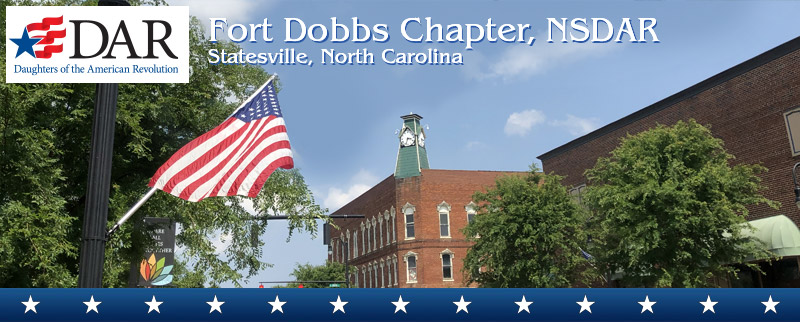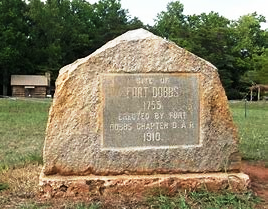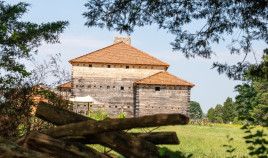
Photo courtesy of chapter archives
Our Chapter
Our chapter has a very interesting history filled with members of two chapters; the Fort Dobbs Chapter, NSDAR, and the Fourth Creek Chapter, NSDAR. These two chapters formally merged on April 15, 2000. Here is how it all began ...
Fort Dobbs Chapter, NSDAR
Fort Dobbs Chapter, NSDAR, was organized on April 29. 1908, by its first regent, assisted by members of the of the Mecklenburg Chapter, NSDAR. The regent had been attending the meetings of the Mary Slocumb Chapter, NSDAR, in nearby Mooresville, North Carolina, traveling by horse and buggy every month. It was a member of this chapter who suggested forming a new Statesville chapter. The original name was the Iredell Chapter, NSDAR. The chapter was named the Fort Dobbs Chapter, NSDAR, on April 29, 1908. In an address at the confirmation ceremony for the chapter, an attendee spoke of the important objectives of the society: “First, to search out and perpetuate in permanent form the history of each locality where such a society is formed, and to encourage a patriotic spirit and love of one’s country; second, to mark in a substantial way the historical places of interest in the county.” The fourteen charter members began their work with enthusiasm and eagerness to fulfill all the objectives of the society. At the May 2 meeting, the members advanced fifty cents each for the purchase of a charter and the treasurer was requested to subscribe to the American Monthly Magazine when funds were available. Annual dues were one dollar for local members and another dollar was to be collected when needed. The out-of-town members paid two dollars.
The first annual report of the chapter was given at the ninth annual meeting of the state society on October 5–6, 1909, in Charlotte. The regent’s report at the annual meeting stated:
During the past year the meetings of our chapter have been interesting and well attended. By a special act of the National Board, the name of our chapter was changed from Iredell to Fort Dobbs. Our first endeavor is to place a marker at the site of the historic Fort Dobbs, a place of refuge for the pioneers of our section.

Photo courtesy of chapter archives
A beautiful floral parade was given October 2 under the auspices of our chapter from which we realized enough to justify our giving an order for the marker, and we hope soon to have it in place. Mr. Hatchett, the present owner of the old Huggins plantation on which the fort stood, has generously given us a deed for a plot of ground 65’ x 100’ on which to place the marker.” (The deed is dated September 25, 1909.
We have inaugurated the giving of a gold medal annually for the best historical essay with especial reference to North Carolina colonial history period being designated by a committee of our members. Only pupils of the three higher grades are eligible to compete for this medal. The members of our chapter are also collecting Colonial and Revolutionary War facts in regard to Iredell County and putting this data into as interesting form as possible — to be bound into book form, in which we hope to preserve artifacts of historical importance and perhaps realize some profit from the sale of the book.
An important part of the program was the unveiling of the granite marker at Fort Dobbs. The members had worked diligently to acquire and erect the marker for the sum of $71.45. Dedicatory exercises were held at Shearer Hall, Mitchell College, with the Reverend Plato Durham delivering the historical address.

Photo courtesy of Julie-Ann Mold
The name of our chapter was changed to Fort Dobbs Chapter, NSDAR, on December 1, 1908. The history of the Fort Dobbs Chapter, NSDAR, and Fort Dobbs State Historic Site have been connected with the chapter’s involvement in the many efforts to preserve and recognize the site. Fort Dobbs Chapter, NSDAR, emphasizes educational outreach in the Iredell County and Statesville Schools as well as support of the DAR school, Crossnore Communities for Children. The chapter also strives to assist and recognize our active-duty military and our veterans of both genders as well as their children through a variety of projects. In addition to their work around conservation, patriotism, women’s issues, and local history, the chapter is quite active and looks forward to a long–standing heritage.
Fourth Creek Chapter, NSDAR
Fourth Creek Chapter, NSDAR, was officially organized at a dinner meeting on November 3, 1959, with the chapter name derived from Fourth Creek Meeting House, now the First Presbyterian Church.
Historic sites preserved by the chapter include the Robert Hill home and the 1700’s North Carolina bi–century Douglas Farm. Besides educational activities, patriotic endeavors have included work involving the compiling of a book of local veterans and their World War II service records.
The Fort Dobbs Connection
All members are encouraged to visit Fort Dobbs. The fort was constructed by Governor Arthur Dobbs in 1755–56 near Statesville, North Carolina, and was used during the French and Indian War. By the end of 1761, the British had essentially won the war and only thirty troops remained at the fort. Colonial leaders disbanded the troops and removed all the supplies of the garrison as settlements moved far west of the fort. The neglected fort was in ruins by 1766. A replica of the fort opened in September 2019.
The content contained herein does not necessarily represent the position of the NSDAR. Web hyperlinks to
non-DAR sites are not the responsibility of the NSDAR, the state organizations, or individual DAR chapters.